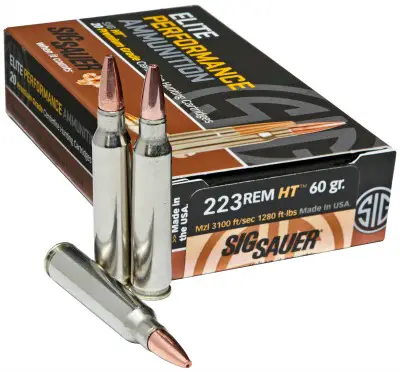|
SIG SAUER Elite Performance Rifle Ammunition  We tested the entire spectrum of the Sig Sauer Elite Performance pistol ammunition in 2016 and found it to be very accurate and effective. The consistency of all loads was impressive. In fact, throughout our testing, we never experienced a flyer. That is not to say that it is not possible, but we didn't have a single flyer or ammunition malfunction of any kind. In the early part of 2017, Sig began to introduce their Elite Performance rifle ammunition. We ordinarily reload our own rifle ammunition for both hunting and competition shooting. However, due to the excellence of the Sig pistol ammo, we could not resist contacting Shannon Jackson (the Sig PR person) and asking her to send us some of their new rifle ammunition. For readers who are not aware, Sig Sauer loads all of their own ammunition. They do not outsource or license their ammunition, as many other companies do. Their new facility in Jacksonville, Arkansas is state of the art. With 70,000 square-feet, there is more than enough room for expansion, as the market demands. Part of this modern facility is an expanded ballistics testing laboratory with Sig R&D personnel on site. The first ammunition to arrive was .223 Remington. This included 40 grain predator-tip ammo with polished brass cases and the 60 grain HT loads with nickel plated cases. Before we go further, it is perhaps useful to discuss the pros and cons of brass cases vs. nickel plated cases. Brass is an alloy of zinc and copper and has several benefits as a cartridge case. First and foremost, it is inexpensive. It is soft enough to facilitate complete expansion in the firearm's chamber without splitting. It will not scratch the metal components of your gun or spark with other metals. It is capable of being resized and reloaded multiple times. Nickel plated cases load easier into a magazine and the rifle's chamber due to their lower coefficient of friction. They are very corrosion resistant, compared to conventional brass cases. However, there is a downside to nickel cases for the reloader. The cases are more brittle and the necks are prone to split after one or more reloads. Nickel cases are harder to resize and after several reloads the plating can begin to flake and scratch the interior of your reloading dies. If a nickel case becomes stuck in your reloading die, you might as well throw the die away. It could not be any tighter if you welded it in place. Where does this leave us? If you are a reloader, stick with brass cased ammo for reloads and if you do not reload, it doesn't matter, unless you plan to venture into very harsh and unforgiving environments and then nickel plated cases are the way to go. This is probably why Sig loaded their .300 Win. Mag. HT hunting ammunition in nickel plated cases. After all, you don't take a .300 Win Mag for squirrel hunting on the back forty. Sig also offers their HT hunting loads in 120 grain .300 BLK and 150 grain 308 Winchester. Below are the specs and results that we obtained in our tests. We did our shooting at 100 yards off of a Caldwell Tack Driver bag. We fired multiple three and four shot groups for record. Group size was measured center to center. Because we don't own any AR platform rifles and our Ruger Mini 14s are not noted for their accuracy, we chose the new Henry Steel Frame Single Shot HO15 rifle for our tests. This little rifle has produced accuracy results rarely found in factory made rifles. Truth be known, target shooters would be well advised to check out this little rifle.  Shooting Results
For a comparison, we also shot our own 55 grain reloads, which we know to be very accurate. There was virtually no difference in the group size. Both loads delivered equally tight, triangular, three shot groups. The Elite Performance rounds are very accurate. Our groups were consistent and very symmetrical, not ragged or strung out. After firing 200 rounds, we did not experience a single flier. This does not guarantee that you might not get one, but we did not. (Flyers are, more often than not, due to shooter error; the Clary's are fine shots. -Editor) This ammunition is also the cleanest we have ever used. There was substantially less fouling in the barrel of our test rifle, even compared to our own reloads. We are not sure what powders SIG is using, but they are very clean burning. We wouldn't mind getting some of this stuff for our reloads. In the meantime, we will continue to shoot Sig Elite Performance ammunition. |